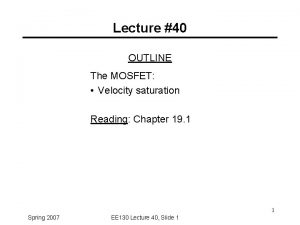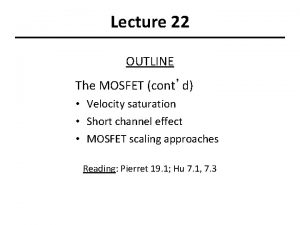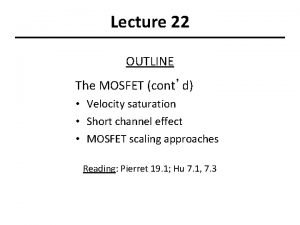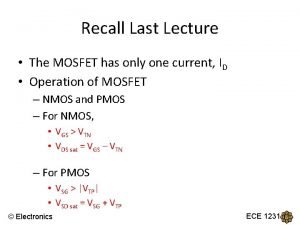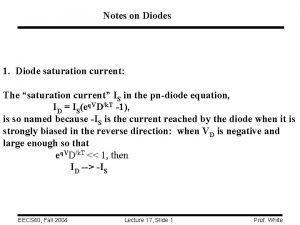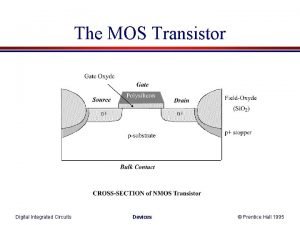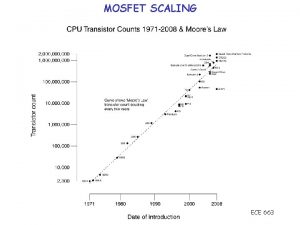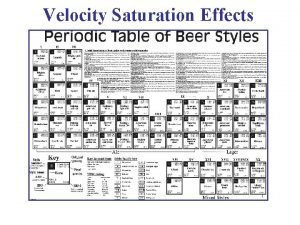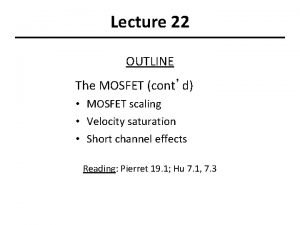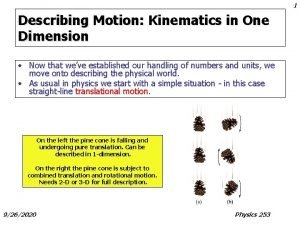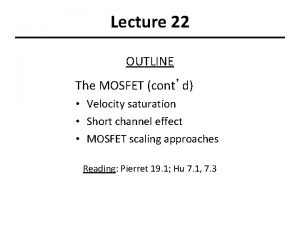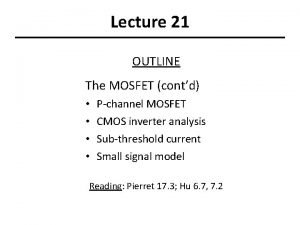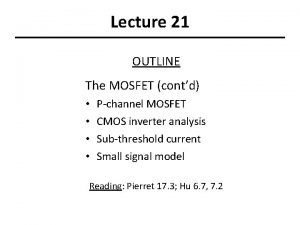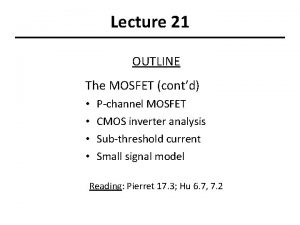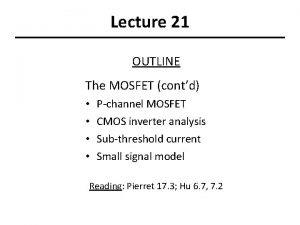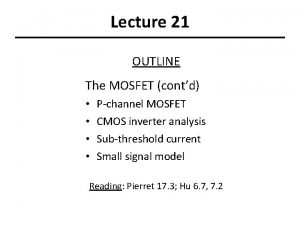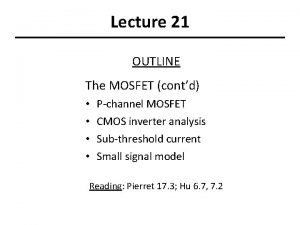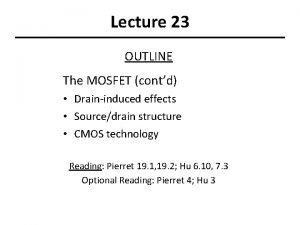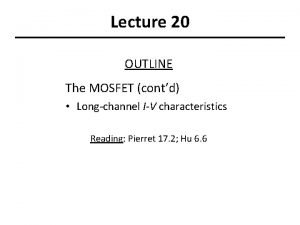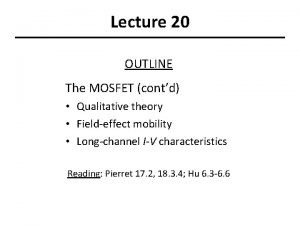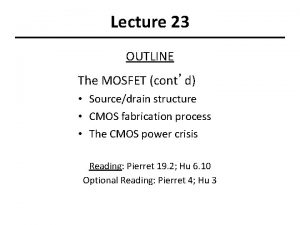Lecture 22 OUTLINE The MOSFET contd Velocity saturation




















- Slides: 20

Lecture 22 OUTLINE The MOSFET (cont’d) • Velocity saturation • Short channel effect • MOSFET scaling approaches Reading: Pierret 19. 1; Hu 7. 1, 7. 3

MOSFET Scaling • MOSFETs have been steadily miniaturized over time – 1970 s: ~ 10 mm – Today: ~30 nm • Reasons: – Improved circuit operating speed – Increased device density --> lower cost per function EE 130/230 M Spring 2013 Lecture 22, Slide 2

Benefit of Transistor Scaling As MOSFET lateral dimensions (e. g. channel length L) are reduced: • IDsat increases decreased effective “R” • gate and junction areas decreased load “C” faster charging/discharging (i. e. td is decreased) EE 130/230 M Spring 2013 Lecture 22, Slide 3

Velocity Saturation Velocity saturation limits IDsat in sub-micron MOSFETS Simple model: for e < e sat for e esat Esat is the electric field at velocity saturation: EE 130/230 M Spring 2013 Lecture 22, Slide 4

MOSFET I-V with Velocity Saturation In the linear region: EE 130/230 M Spring 2013 Lecture 22, Slide 5

Drain Saturation Voltage, VDsat • If esat. L >> VGS-VT then the MOSFET is considered “long-channel”. This condition can be satisfied when – L is large, or – VGS is close to VT EE 130/230 M Spring 2013 Lecture 22, Slide 6

Example: Drain Saturation Voltage Question: For VGS = 1. 8 V, find VDsat for an NMOSFET with Toxe = 3 nm, VT = 0. 25 V, and WT = 45 nm, if L = (a) 10 mm, (b) 1 mm, (c) 0. 1 mm (d) 0. 05 mm Solution: From VGS , VT and Toxe, meff is 200 cm 2 V-1 s-1. Esat= 2 vsat / meff = 8 104 V/cm m = 1 + 3 Toxe/WT = 1. 2 EE 130/230 M Spring 2013 Lecture 22, Slide 7

(a) L = 10 mm: VDsat= (1/1. 3 V + 1/80 V)-1 = 1. 3 V (b) L = 1 mm: VDsat= (1/1. 3 V + 1/8 V)-1 = 1. 1 V (c) L = 0. 1 mm: VDsat= (1/1. 3 V + 1/. 8 V)-1 = 0. 5 V (d) L = 0. 05 mm: VDsat= (1/1. 3 V + 1/. 4 V)-1 = 0. 3 V EE 130/230 M Spring 2013 Lecture 22, Slide 8

IDsat with Velocity Saturation Substituting VDsat for VDS in the linear-region ID equation gives For very short channel length: • IDsat is proportional to VGS–VT rather than (VGS – VT)2 • IDsat is not dependent on L EE 130/230 M Spring 2013 Lecture 22, Slide 9

Short- vs. Long-Channel NMOSFET Short-channel NMOSFET: • IDsat is proportional to VGS-VTn rather than (VGS-VTn)2 • VDsat is lower than for long-channel MOSFET • Channel-length modulation is apparent EE 130/230 M Spring 2013 Lecture 22, Slide 10

Velocity Overshoot • When L is comparable to or less than the mean free path, some of the electrons travel through the channel without experiencing a single scattering event projectile-like motion (“ballistic transport”) Þ The average velocity of carriers exceeds vsat e. g. 35% for L = 0. 12 mm NMOSFET Þ Effectively, vsat and esat increase when L is very small EE 130/230 M Spring 2013 Lecture 22, Slide 11

The Short Channel Effect (SCE) “VT roll-off” • |VT| decreases with L – Effect is exacerbated by high values of |VDS| • This effect is undesirable (i. e. we want to minimize it!) because circuit designers would like VT to be invariant with transistor dimensions and bias condition EE 130/230 M Spring 2013 Lecture 22, Slide 12

Qualitative Explanation of SCE • Before an inversion layer forms beneath the gate, the surface of the Si underneath the gate must be depleted (to a depth WT) • The source & drain pn junctions assist in depleting the Si underneath the gate – Portions of the depletion charge in the channel region are balanced by charge in S/D regions, rather than by charge on the gate Þ Less gate charge is required to invert the semiconductor surface (i. e. |VT| decreases) EE 130/230 M Spring 2013 Lecture 22, Slide 13

The smaller L is, the greater the percentage of depletion charge balanced by the S/D pn junctions: depletion charge supported by gate (simplified analysis) VG n+ n+ p D S D Depletion charge supported by S/D EE 130/230 M Spring 2013 depletion region Small L: Large L: S rj Lecture 22, Slide 14

First-Order Analysis of SCE • The gate supports the depletion charge in the trapezoidal region. This is smaller than the rectangular depletion region underneath the gate, by the factor WT • This is the factor by which the depletion charge Qdep is reduced from the ideal • One can deduce from simple geometric analysis that EE 130/230 M Spring 2013 Lecture 22, Slide 15

VT Roll-Off: First-Order Model Minimize DVT by • reducing Toxe • reducing rj • increasing NA (trade-offs: degraded meff, m) Þ MOSFET vertical dimensions should be scaled along with horizontal dimensions! EE 130/230 M Spring 2013 Lecture 22, Slide 16

MOSFET Scaling: Constant-Field Approach • MOSFET dimensions and the operating voltage (VDD) each are scaled by the same factor k>1, so that the electric field remains unchanged. EE 130/230 M Spring 2013 Lecture 22, Slide 17

Constant-Field Scaling Benefits • Circuit speed improves by k • Power dissipation per function is reduced by k 2 EE 130/230 M Spring 2013 Lecture 22, Slide 18

• Since VT cannot be scaled down aggressively, the operating voltage (VDD) has not been scaled down in proportion to the MOSFET channel length: EE 130/230 M Spring 2013 Lecture 22, Slide 19

MOSFET Scaling: Generalized Approach • Electric field intensity increases by a factor a>1 • Nbody must be scaled up by a to suppress short-channel effects • Reliability and power density are issues EE 130/230 M Spring 2013 Lecture 22, Slide 20
 Vdssat
Vdssat Mosfet
Mosfet Velocity saturation
Velocity saturation Address contd
Address contd Pmos saturation current equation
Pmos saturation current equation Saturation current diode
Saturation current diode Velocity saturation
Velocity saturation Mosfet scaling
Mosfet scaling Velocity saturation
Velocity saturation Velocity saturation
Velocity saturation Idsat mosfet
Idsat mosfet 01:640:244 lecture notes - lecture 15: plat, idah, farad
01:640:244 lecture notes - lecture 15: plat, idah, farad Final velocity initial velocity acceleration time
Final velocity initial velocity acceleration time Initial velocity and final velocity formula
Initial velocity and final velocity formula Tangential speed
Tangential speed Dynamics acceleration equation
Dynamics acceleration equation Tangential speed
Tangential speed Darcy law
Darcy law Instantaneous velocity vs average velocity
Instantaneous velocity vs average velocity Angular quantities
Angular quantities Derivation of darcy's law
Derivation of darcy's law
